The Pavesi Model 1942 is a prototype Italian semiauto rifle chambered for the 8×59 Breda cartridge. It is a short recoil action with a 4-lug rotating bolt, and appears to use a Mannlicher type en bloc clip like a Carcano (no sample clip was available for me to look at). It is marked on the chamber “ARMA PAVESI-FNA BREVETTO N.365273”, although I have not been able to find a patent bearing that number. The top of the rear bolt cover is marked “Semiautomatico cal.8 – mod. 1942 -xx – Brescia”. It has no serial number that I could find.
I have not been able to find any substantive information on exactly who made the rifle, if or when it was tested, or what the results of any testing may have been. The 1942 date puts this well after the main Italian self-loading rifle trials, which concluded in the adoption (although not the mass production) of the Armaguerra Model 1939, in 1939.
This Pavesi example is held in the Beretta reference collection in Brescia. Many thanks to Beretta for allowing me to take a look at it!
Pavesi Model 1942



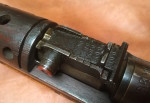











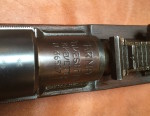

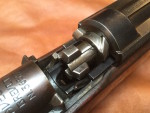
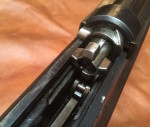
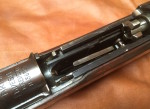


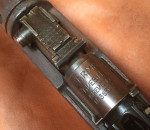
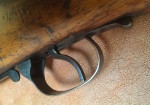
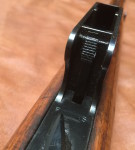


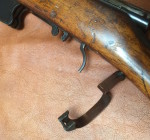
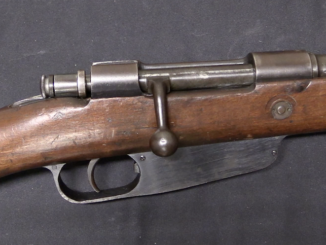
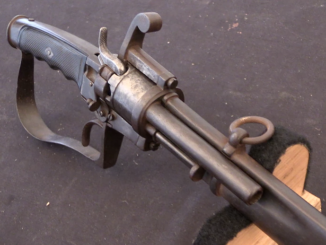
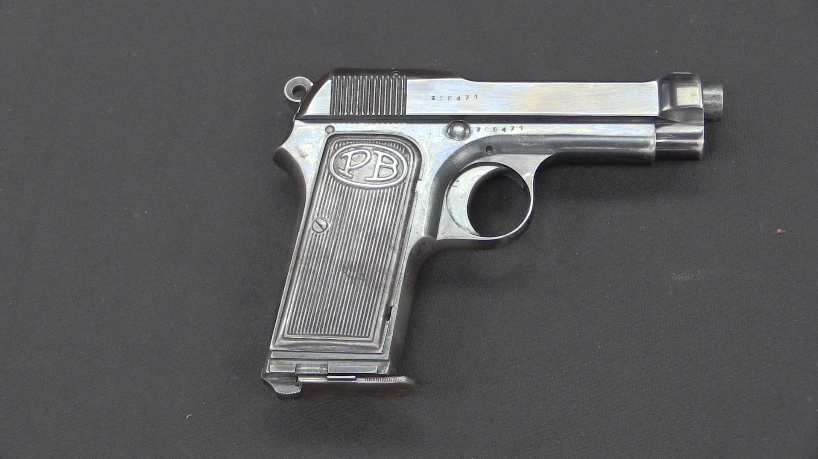
A .zip file download of the gallery would be wonderful, if you have time to do that. Very interesting rifle, that’s for sure.
Note the very serious muzzle brake. The 8 x 59 Breda round was only slightly less powerful than the .300 H & H Magnum, with proportionately exuberant recoil.
A shoulder-fired rifle in this “big game” type caliber would almost certainly need some form of recoil attenuation to avoid problems like turning the shooter’s shoulder black-and-blue, especially if sustained fire were contemplated.
For an interesting comparison, consider the muzzle brake of the Swedish Army issue Model 40 Mauser in 8 x 63 M1932 (not the same as, or interchangeable with, 8mm-’06), that was used by machine gun troops operating the Browning MG in that caliber.
The 8 x 59 and 8 x 63 rounds have nearly identical ballistics with equal bullet weights, and therefore probably roughly equivalent “whomp” at both ends.
A muzzle brake would be just good common sense, in both cases.
cheers
eon
“8 x 63 M1932”
Norway also used special purpose machine gun cartridge: 7,92×61
https://4bf57f651b7c7ab0ee16b663a034b4576c7918e5.googledrive.com/host/0B1W_bs7pDx-TRFI0S3NnU1VjT1k/files/7,92×61%20Norwegian/Информация/Патрон%207,92×61%20Norwegian.html
firing 14,2g (220 grains) bullet at 775 m/s (2542 fps), notice that all nations which used special machine gun cartridge (Norway, Sweden, Italy) used 6.5 in their rifles (Norway – 6.5×55 Swedish, Sweden – 6.5×55 Swedish, Italy – 6.5×52 Carcano) which were good for rifles and quite good for light machine guns, but lacked in medium machine guns.
–
8×68 S is still alive (at least in Germany) cartridge with ballistic similar to mentioned 8x63mm patron m/32, however so far I know 8×68 S was designed as hunting cartridge, not military one.
“serious muzzle brake”
I have that this element is often overlooked.
For examples thanks to muzzle brake it was become to fire wz. 35 Polish AT rifle without wounds to shooter. Look at its ballistic:
CARTRIDGE: 7.9-mm cartridge with DS bullet
MUZZLE VELOCITY: 1265+/-24 m/s (really fast for 1930s technology)
BULLET: 12,8g (~198.4 grains)
But apparently Polish designer were working on scaled-up version of this cartridge:
http://naboje.org/node/8770
i.e. 13×178, sadly I don’t have any info besides what is link. I wonder why these cartridges are rather long than fat – does Polish powder MUST have such shape of case to work?
Less that than the geometry of a Mauser-type or other bolt-action system. Most such feed systems don’t work that reliably with short, fat cartridges.
Generally, a cartridge of about the proportions of a 7.9 x 57 or 7.62 x 63 round will feed reliably even when the rifle is bolted hurriedly (potentially short-stroking the action). Shorter rounds of the proportions of the 7.62 x 39 tend to “popup” or “nosedive” under such conditions unless in a true controlled-feed rifle.
Keep in mind that self-loading systems generally have more power available for feeding and extraction/ejection than manual repeating systems. Lever actions, while generally a bit lacking in the primary extraction department (due to non-rotating bolts; the Winchester Model 88 and Sako Finnwolf are both exceptions, IIRC), make up for it relative to bolt guns due to the lever system giving them a major mechanical advantage.
A cartridge for a bolt-action combat rifle needs to feed absolutely reliably with as little force applied as possible. As such, relatively long, skinny cartridge cases tend to do better in that sort of application.
cheers
eon
There was also experimental Polish 10×99 cartridge:
http://naboje.org/node/8990
With more fat than long case, again I don’t have any further information. I wonder about relation of 10×99 to 13×178, which was first, were they challengers? Who designed that cartridges?
Very ınteresting but complicately made rifle. The latch at left in front of the hand guard, seems a lock blocking the barrel recoil and enabling the gun to be used as a straight pull manual loader. The barrel and breechbolt have their separate return springs and the barrel seems not waiting to join with the breechbolt in recoiled back situation. The barrel return spring seems optimal strength to transmit sufficient momentum to the breechbolt but remaining in the weak level to dumpen the recoil impact of big massed barrel and the muzzle brake should have been added to soften that violent stroke.
I think Paul Mauser lost an eye to one of his recoil-operated prototype rifles…
I’ve not managed to find anything using that patent number.
I have a question it is however not directly related to this particular firearm. I have seen quite a few different firearms of different ages with metal parts that have turned that rather attractive maroon/purple color but never found a realistic sounding reason. Some of the reasons i have heard were that it had to do with the metal quality, the way it was treated or, the finish on the particular parts. But it seems to appear almost randomly even in two of the same firearm of comparable age/serial range.
Any ideas what is the real reason for that color change?
According to George C. Nonte in Pistolsmithing, the two most common reasons for colors “other than blue” in gun bluing are;
1. Inadequate control of the temperature of the bluing bath. It should never be allowed to go below 292 degrees F or above 300. Low temperature results in a grayish cast, high in reddish color. If temperature fluctuates too much while bluing is in progress, you can get what looks like a “good” finish, but patches or even areas will turn greyish or reddish-purple over time, depending on which way the temperature varied.
2. The actual composition of the metal. This is especially true of inexpensive arms made before WW2 in Europe. Many pistols and revolvers had frames of “cast steel” that was more like cast iron, and which react strangely to even advanced modern bluing baths like Brownell’s Oxynate 7.
Some military and commercial Mauser rifles made by firms “other than DWM” between the wars have receivers of relatively “soft” steel with less nickel content that is considered optimum. They can be turned all sots of odd colors by bluing baths.
Generally, the more the result looks like “color case-hardening” on a black-powder frame Colt Peacemaker, the less advisable it is to fire the rifle, and the incredibly inadvisable it would be to use it as an action for a custom rifle chambered for some nuclear-powered, hyper-velocity “wildcat” load.
You might- might– get away with something like the old .257 Roberts with your head still attached. Don’t even think about some warp-speed wonder like the .240 Hawk, or anything named “Weatherby” or “Lazzeroni Fire-Anything”.
cheers
eon
There is a trick to try to get around the reddish color if it starts showing up–it involves an extremely toxic chemical. Even then though, the red can show up years later.
Used to have an uncle who was a gunsmith. He did his own bluing and died of liver cancer. Apparently not an uncommon story. Maybe it is safer these days, if I ever tried it I think I would use a forced air respirator.
You have my sympathy.
Nonte always insisted on using a respirator around a bluing bath, as the fumes are as caustic as the liquid is. The hazards of such fumes were known but not well understood as far back as the 1800s. Much like the old (true) story about hatters who made toppers from beaver pelts suffering hallucinations and worse due to the fumes from the mercury-bearing bleaching baths they used.
“Industrial environmental” hazards are nothing new, unfortunately.
sincerely,
eon
Citing a specific example only: The SVT-40’s re-arsenal-ized by the Soviets after WW2 had their bolt parts treated in a ‘plum’ red/purple color. SVT-40’s captured by the Finnish during the winter war/continuation war, were left in white metal. I don’t know which process(es) were used for this treatment.
The Italian semiauto rifle reviews are great but I noted on both of them that no clips were available. I would suggest contacting the International Ammunition Association http://cartridgecollectors.org/ One of the columns in their magazine is called Clipart and it is all about stripper clips, enclosed clips, packets, etc. They may have info on what these rifles used because the author of the column loves the more obscure items in this world of study
Guys, some years ago back in the mid 80’s I got to handle and inspect a Pavesi Model 1942 rifle in a private collection. From some scant notes I made back then and looking at Ian’s video it jogged my memory somewhat as to the rifle. The muzzle device was an after thought added to try and delay the recoil action by blowing forward the barrel, quite how effective it was is unknown. The bolt when unlocked as Ian shows, is not restrained by a spring for the first part of the cycle after unlocking. This allowed the bolt to ‘accelerate’ to the rear until it is decelerated by the combined buffer/return spring and is allowed to return forward, stripping a round from the en block clip and chambering it then locking and returning the barrel into battery. Note that when loading a round the bolt is traveling under it’s own inertia after being propelled only part of it’s way into battery by the combined buffer/return spring! Quite a convoluted action and mechanism and not an action that would have worked well if fouled by debris. I remember I found the accelerator aspect of the action fascinating but had to wonder ‘why’?
If the latch at left in front of foreend is intended to convert the gun from auto to manual loader, this explains the cause of different lay out of Pavesi rifle. Automatic reloading would work against to both, barrel and breechbolt springs and manual reloadind should work against to the weakest single return spring possible. This should be the reason why separate foremost travel for barrel and breechbolt and separate return springs were used. Besides, the barrel should be in the foremost position to accept the rotating head of brechbolt for ensured loading and this might be the answer why an accelerator in the shape of muzzle brake were used.
As I understood the design, the muzzle device was added to ‘delay’ the barrel recoiling BOT to aid it!
Sorry, NOT to aid it…. typo 😉
Jesus.
Sorry to necropost here, but I’m wondering how the brake is held on to the muzzle. It’s obvious that it’s threaded, but there looks to be some kind of spring clip that engages the brake to the threads to keep it from back in off. Am I correct in that assumption?
Video is missing here !